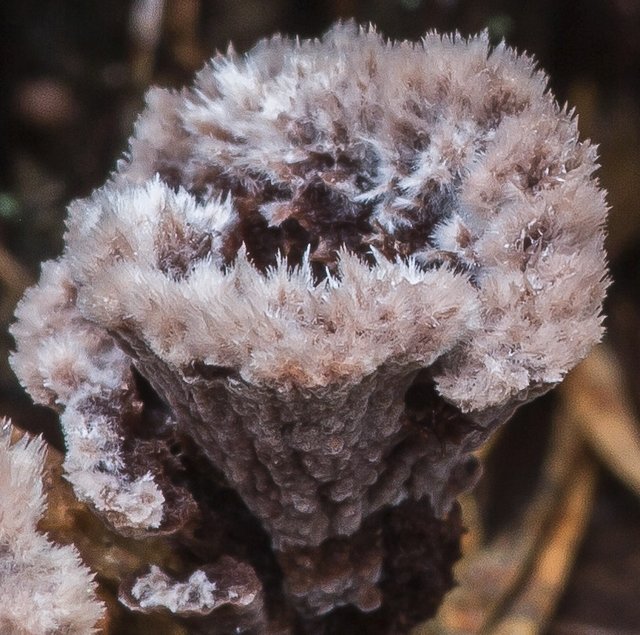Telephora brush (Thelephora penicillata)
- Division: Basidiomycota (Basidiomycetes)
- Subdivision: Agaricomycotina (Agaricomycetes)
- Class: Agaricomycetes (Agaricomycetes)
- Subclass: Incertae sedis (of uncertain position)
- Order: Thelephorales (Telephoric)
- Family: Thelephoraceae (Telephoraceae)
- Genus: Thelephora (Telephora)
- Type: Thelephora penicillata (Telephora brush)
:
- Merisma crestatum var. painted
- Merisma fimbriatum
- Thelephora cladoniiformis
- Thelephora cladoniaeformis
- Thelephora very soft
- Thelephora spiculosa

Fruit body: Short-lived small rosettes growing directly on the forest floor or on heavily rotted wood residues, not only on stumps, but also on fallen branches. An interesting feature: if the sockets grow on the ground, they have a rather “tortured” look, as if they were trampled, although in fact no one touched them. Sockets that have chosen rotten stumps for residence look much prettier.
Violet, violet-brown, reddish-brown at the base, brownish towards the forked tips. The tips of the rosettes are strongly branched, ending in pointed spines, creamy, creamy, white on the spines themselves.
Mycologists do not yet have a clear and unambiguous opinion whether telephora is a brush fungus that forms only mycorrhiza with various living trees, or a saprophyte that feeds on dead and decaying wood residues, needles and leaves on forest soil, or it can be both.
Outlet dimensions: 4-15 centimeters across, individual spines 2 to 7 centimeters long.
Pulp: Soft, fibrous, brown.
Smell: does not differ, mushrooms smell of earth and dampness. There is a mention of a clearly distinguishable anchovy smell.
Taste: soft, indistinguishable.
Spores: Angular ellipsoidal, 7-10 x 5-7 µm with warts and bumps.
Spore powder: Purplish brown.
In coniferous and deciduous forests, from July to November. Prefers to grow in moist acidic coniferous forests, sometimes can be found in mossy areas not only under coniferous, but also under broad-leaved trees. Distributed throughout mainland Europe, including the UK and Ireland, registered in Our Country and North America.
There is no data on toxicity. The mushroom is considered inedible: there is no taste, the pulp is thin, it is of no culinary interest and does not cause a desire to experiment with the recipe.
Terrestrial telephora (Thelephora terrestris) is much darker, most often found on dry sandy soils, especially with pines and less often under broad-leaved trees, also occasionally found with various eucalyptus trees.
Telephors are sometimes referred to as “earth fans”. In the UK, Telephora brush is protected not only as a rather rare species, but also because of its difficult relationship with some types of orchids. Yes, yes, orchids are appreciated in good old England. Remember, “The Hound of the Baskervilles” – “It’s too early to admire the beauties of the swamps, orchids have not yet bloomed”? So, rare saprophytic orchids, including Epipogium aphyllum, Orchid Ghost and Coralorrhiza trifida, Oralid Coralroot parasitize on mycorrhiza, which is formed between trees and telephors. The ghost orchid, in particular, is much rarer than, for example, Thelephora penicillata.
Photo: Alexander









